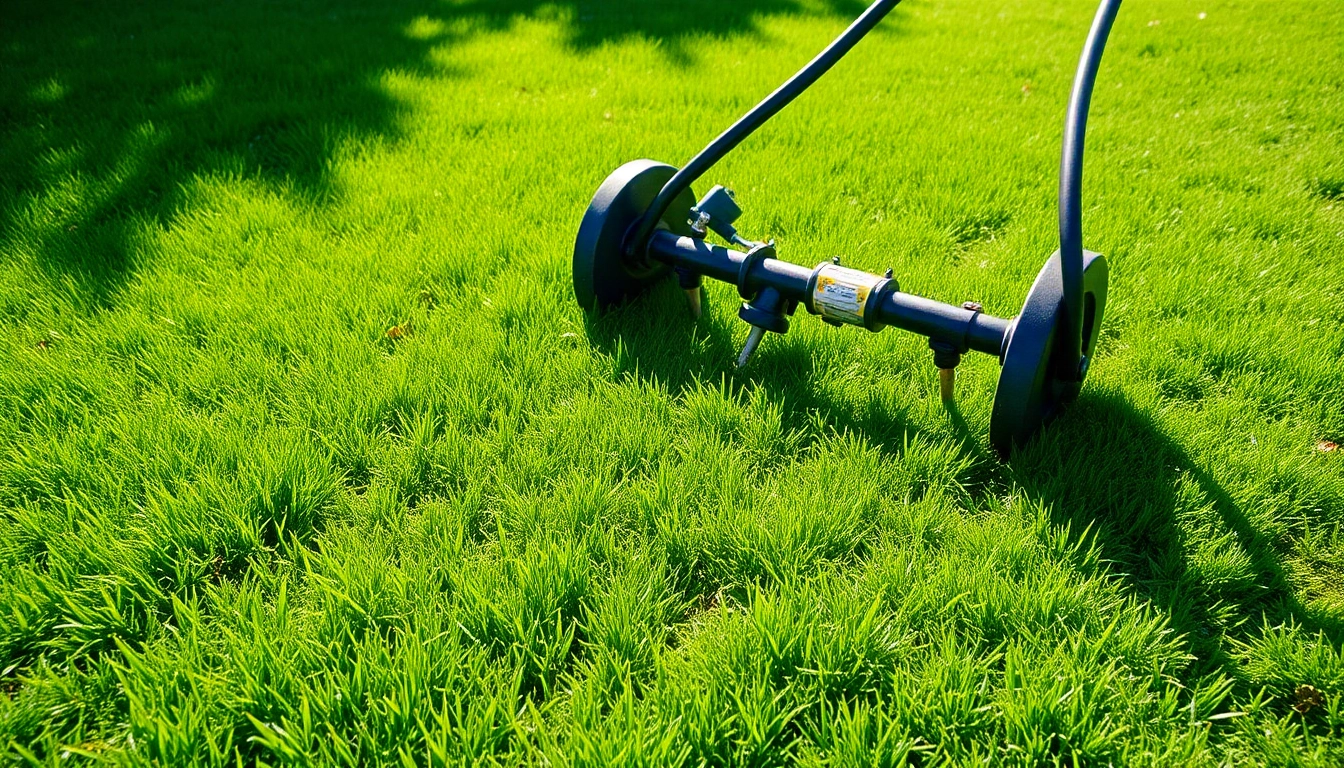Understanding Core Aeration
What is Core Aeration?
Core aeration, also known as plug aeration, is a crucial process in lawn care that involves removing small plugs of soil from the lawn to enhance its health. Using a specialized machine, a lawn aerator, this method creates holes approximately ½ to ¾ of an inch in diameter, allowing crucial elements such as water, air, and nutrients to reach the grassroots. This process is particularly beneficial for compacted soils, which often translates into healthier grass and a more vibrant lawn overall. Additionally, core aeration can help reduce thatch build-up and improve the overall structure of the soil, making it a vital component of any robust lawn care regimen.
Benefits of Core Aeration for Lawn Health
The advantages of core aeration come from its ability to directly impact several key areas of lawn health:
- Improved Soil Structure: By removing soil plugs, aeration alleviates soil compaction, which enhances root development and promotes better water absorption.
- Enhanced Air Exchange: The removal of soil cores allows for better air flow throughout the lawn, aiding in the exchange of gases between the soil and the atmosphere, which is vital for plant health.
- Increased Nutrient Uptake: Following core aeration, nutrients in fertilizers can penetrate deeper into the soil, making it easier for grass roots to access essential sustenance.
- Improved Drought Resistance: An aerated lawn can retain water more effectively, helping it withstand periods of drought by enabling deeper rooting.
- Enhanced Overall Health: The combination of improved air, water, and nutrients culminates in a lush, green lawn that is healthier and more resilient to pests and disease.
Common Misconceptions about Core Aeration
Despite its numerous benefits, there are misconceptions surrounding core aeration that can deter homeowners from engaging in this beneficial practice:
- Myth: Aeration is Only Necessary for New Lawns: In reality, all lawns can benefit from aeration, particularly established ones that have high foot traffic or suffer from compaction.
- Myth: Core Aeration Creates a Mess: While soil plugs are left on the surface, they will decompose quickly and offer beneficial organic matter back to the soil.
- Myth: It is Not Worth the Investment: Given the potential improvement in lawn health and reduction in watering and fertilizer needs, the long-term benefits far outweigh the initial costs.
When to Perform Core Aeration
Best Seasons for Core Aeration
Timing is crucial when it comes to core aeration. The best seasons typically depend on the type of grass. For cool-season grasses, early spring or early fall are the ideal times for aeration. This allows the grass to recover well and encourages growth during its peak season. Conversely, warm-season grasses should be aerated in late spring or early summer. Aerating during the right growth periods helps ensure that the grass can quickly heal and take full advantage of the benefits of aeration.
Signs Your Lawn Needs Core Aeration
Recognizing the need for core aeration is essential in maintaining a vibrant lawn. Some signs that your lawn may require aeration include:
- Visible areas of compaction, such as hard, bare spots.
- Pooling water after rain or irrigation might indicate compacted soil preventing proper drainage.
- Thin, sparse grass that has difficulty growing, possibly due to competition for nutrients and water.
- Excessive thatch buildup, which is a layer of dead grass and roots that can suffocate healthy grass.
How Often Should Core Aeration Be Done?
For optimal lawn health, core aeration should generally be performed every one to two years. However, factors like foot traffic and soil type can influence this frequency:
- High Foot Traffic: If your lawn sees heavy use, consider annual aeration to mitigate compaction.
- Soil Type: Clay soils tend to compact more easily and may require more frequent aeration compared to sandy soils.
Ultimately, assessing your specific lawn conditions will help guide the aeration schedule.
How to Perform Core Aeration
DIY Core Aeration Techniques
For homeowners interested in executing core aeration themselves, following a few simple steps can lead to successful results:
- Choose the Right Equipment: Invest or rent a core aerator that can efficiently handle your lawn size.
- Prepare the Lawn: Mow the grass to a lower height and water it the day before aeration to ensure the soil is moist yet firm.
- Aerate the Lawn: Pass the aerator over the lawn, making sure to cover the entire area without overlapping too much. For heavily compacted areas, you may want to go over those sections twice.
- Leave the Soil Plugs: Allow the cores to decompose naturally as they will add organic matter back to the soil.
Using Professional Aeration Services
If you prefer to leave it to the professionals, many lawn care services offer core aeration as part of their maintenance packages. Hiring a professional can be especially beneficial for those with large properties or complex lawn issues, as they will have access to high-quality equipment and expertise that can yield better results. Additionally, professionals can often assess the specific needs of your lawn, ensuring tailored care that addresses all of its requirements.
Equipment Needed for Effective Core Aeration
Whether you’re performing core aeration yourself or working with a professional team, understanding the necessary equipment is crucial:
- Core Aerator: The primary tool needed, available in both manual and gas-powered versions.
- Spike Aerator: While not as effective as a core aerator, it can be useful for lawns that do not require deep aeration.
- Rake and Broom: After aeration, a rake can help distribute any displaced soil or thatch.
Post-Care Tips After Core Aeration
Watering Your Lawn After Aeration
Post-aeration care is just as important as the aeration process itself. Proper watering is vital. Here’s how to approach it:
- Water the lawn thoroughly after aeration to help the soil settle and ensure that the new holes fill with vital nutrients and moisture.
- Maintain a consistent watering schedule for several weeks post-aeration, keeping the soil consistently moist but not soggy.
Fertilizing after Core Aeration
Applying fertilizer after aeration can offer immediate benefits, as the open holes will allow the nutrients to penetrate the soil more effectively. Consider these tips for fertilizing:
- Choose a slow-release fertilizer to provide nutrients over time; this minimizes the risk of burning the newly aerated grass.
- Apply fertilizer evenly across the lawn, ensuring every area receives the nutrients it needs to thrive.
Overseeding: A Perfect Complement to Aeration
Overseeding is often recommended following aeration to help fill in any bare spots and encourage robust lawn growth. The benefits include:
- Improved density of your lawn, which can lead to a healthier and more resilient turf.
- Enhanced resistance against weeds and diseases through competitive growth.
To overseed effectively, spread quality grass seed after aeration, ensuring the seeds fall into the holes created during the aeration process for optimal soil contact.
Maximizing the Benefits of Core Aeration
Combining Core Aeration with Other Lawn Care Practices
For best results, core aeration should be part of a broader lawn care strategy. Consider integrating these practices:
- Regular Mowing: Maintain an optimal grass height to promote growth while discouraging weed establishment.
- Seasonal Fertilization: Implement a fertilization schedule tailored to your lawn’s specific nutrient needs.
- Proper Watering: Establish a routine that matches the climate and season to sustain lawn health.
Monitoring Lawn Health Post-Aeration
Once aeration and subsequent care steps are complete, it’s essential to monitor the lawn for signs of success:
- Look for increased lushness in the grass blades and newly sprouting growth.
- Check the soil’s drainage capability by observing how quickly water absorbs during irrigation.
- Watch for improved resistance to common issues like weeds or patchiness.
Long-Term Care Strategies for Aerated Lawns
Sustaining lawn health long-term requires a continuous commitment to proper care. Here are essential strategies:
- Implement seasonal aeration to counteract soil compaction based on the lawn’s observed performance.
- Continue periodic inspections for signs of stress or disease, enabling proactive intervention.
- Adjust care practices as seasonal changes warrant, ensuring alignment with the specific needs of the lawn.






